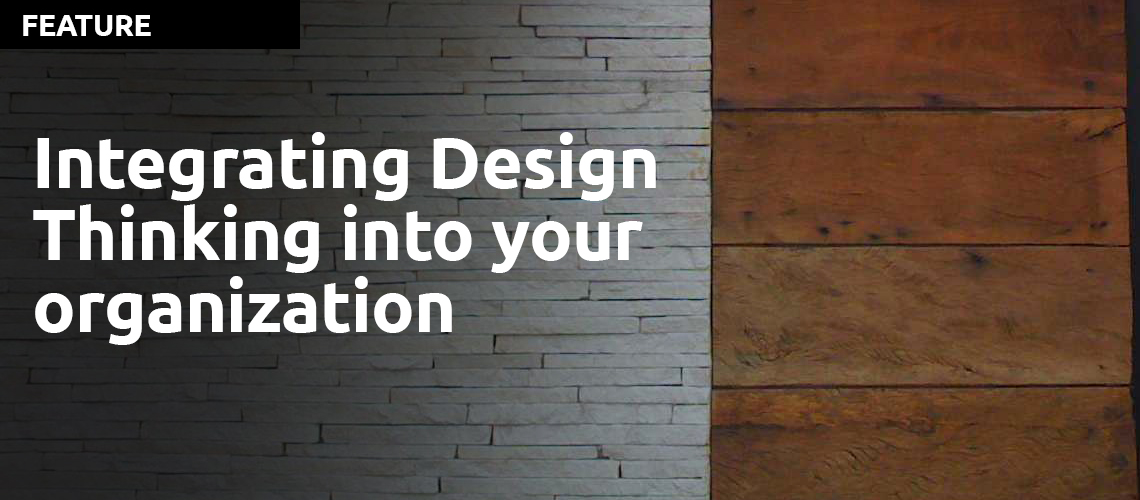
In a recent Design Thinking Association survey, we discovered that implementing and integrating Design Thinking into the organization is considered the most difficult part of the Design Thinking process.
There are literally millions of articles written on Design Thinking, but very few that address the challenge of implementing Design Thinking into existing business processes.
Where to start?
In an article entitled "Design Thinking as a Strategy for Innovation" Linda Naiman says that SAP describes its design thinking journey (integration) as one that developed from a set of tools, to a methodology, to a mind-set, and finally becoming a corporate culture. Perhaps this is the best clue to think about how you can integrate Design Thinking into your corporation. Note: it definitely implies that this is a journey that is going to take years, not weeks or months.
It might be helpful to think about integration as a maturity matrix that you would need to work on. This would perfectly align with the process of learning how to do design thinking and how to get better at design thinking. Looking at integration in this way would also help you to set expectations within your organization as to how much design thinking can contribute at each level of maturity.
There is little evidence to support this view and little research on the subject of design thinking maturity vs design thinking's contribution to value creation in an organization.
However, if you take this as an idea to create a framework that could help you in your quest to successfully integrate design thinking into your organization you might find that it helps you to create a set of steps and help you think of ways that you can more successfully integrate Design Thinking. It will probably also mean that you would need to lead each target group from Executive leadership through functional leadership to peers and collaborators on the project through the maturity phases and that can be a daunting thought. However, any culture change is going to require a lot of work.
Here are some articles and findings that we found of interest on the subject while researching this article:
- To Frame or Reframe: Where Might Design Thinking Research Go Next? - Sara L Beckman
- Good description of the different problem solving activities within Design Thinking to help understand how they work and what sort of support they would need to fit into normal business processes
- Applying Design Thinking Principles in Product Management - Sara L Beckman
- Implementing design thinking in organizations: an exploratory study - David Dunne
- The author outlines some of the big issues around integrating Design THinking into a corporate culture and points to the importance of leadership buy in, but does not necessarily describe answers to how to integrate the process. A good read to understand how you are doing versus others struggling to achieve a successful implementation.
- How to apply design thinking in your organization - Jonathan Follett and Mary Treseler
- The Authors point to some really good resources to help you find answers. The conclusion is that senior management buy-in is the most powerful way to progress with an integration into the corporations processes.
- Diffusion of ‘Design Thinking’ mindset into organizations - Nima Torabi
- The author provides a good overview of the ways in which Design Thinking can be integrated into the corporation
- Some good examples and presentations are used to shed light on how to integrate by companies such as Lockheed Martin, Intuit, GE, IBM
- The author concludes that integration may require cultural and potentially structural changes to successfully integrate and further siting 4 determinants for success:
- Top management needs to support, ease and encourage needed changes
- Design thinking should not be applied in an isolated manner — also termed as organizational embeddedness
- Giving design thinking, time, on the project and the organizational level
- The right place - a place where things can be messy and flexible
- Integrating Design Thinking into Organizations - Lassi Likkanen
- The Stanford and Aalto University scholars present their model of design impact using the concepts of wide and deep design capabilities. Deep refers to the extent of actual design expertise—shallow versus deep—while width describes how broadly design capabilities are distributed across an organization. A design-driven organization requires both deep and wide design capabilities to succeed.
- According to these two studies, the formula for design success in a company requires all of the following:
- solid, empowered design leadership
- a network of design professionals
- strong executive commitment providing external motivation
- credible, tangible, quick wins providing internal motivation
- an organization-wide commitment to improving the customer experience
- The study also recognizes that in order for Design thinking and a design culture to endure, you also need a process and strategic commitment to keep them intact i.e. remember that corporate leaders move on.
- 5 Steps to Integrating Design Thinking into your Group - Jonathan Silk
- The author describes the important role that the leader of the group or corporation plays in guiding the integration of Design Thinking into the organization.
